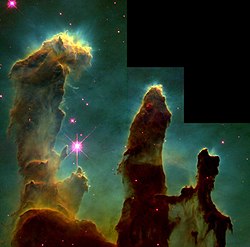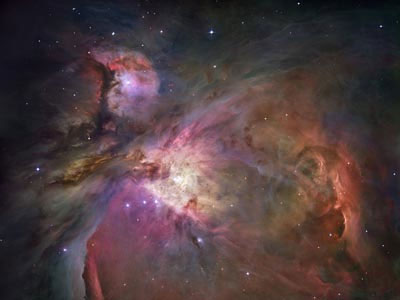Stars are born in an enormous cloud of interstellar dust and hydrogen gas called a nebula. Nebulae represent the building blocks for stars,galaxies,and planets in the universe.
Emission nebulae are hot,discrete clouds of primarily ionized hydrogen that glow with their own light. Reflection nebulae emit a bluish glow by reflecting the scattered light of nearby stars. Absorption nebulae, or dark nebulae, comprise dence clouds of gas and dust. They appear as silhouettes against the light of brighter objects.
Nebulae forms when stars die. When the end comes for our sun. for example it’s outer layer heat,swell, and eventually blow off. The hot, dead core will create a glowing nebula, which will in turn become a nursery for new stars.
•WHY ARE NEBULAE IMPORTANT?
Planetary nebulae are important objects in astronomy because they play a crucial role in the chemical evolution of the galaxy, returning material to the interstellar medium which has been enriched in heavy elements and other products of nucleosynthesis (such as carbon, nitrogen, oxygen and calcium).

The “Pillars of Creation” from the Eagle Nebula. Evidence from the Spitzer Telescope suggests that the pillars may already have been destroyed by a supernova explosion, but the light showing us the destruction will not reach the Earth for another millennium
Most nebulae are of vast size; some are hundreds of light-years in diameter. A nebula that is visible to the human eye from Earth would appear larger, but no brighter, from close by. The Orion Nebula, the brightest nebula in the sky and occupying an area twice the diameter of the full Moon, can be viewed with the naked eye but was missed by early astronomers. Although denser than the space surrounding them, most nebulae are far less dense than any vacuum created on Earth – a nebular cloud the size of the Earth would have a total mass of only a few kilograms. Many nebulae are visible due to fluorescence caused by embedded hot stars, while others are so diffused they can only be detected with long exposures and special filters. Some nebulae are variably illuminated by T Tauri variable stars. Nebulae are often star-forming regions, such as in the “Pillars of Creation” in the Eagle Nebula. In these regions, the formations of gas, dust, and other materials “clump” together to form denser regions, which attract further matter, and eventually will become dense enough to form stars. The remaining material is then believed to form planets and other planetary system objects.
•TYPES OF NEBULA
There are five types of cloudy or nebulous objects in the sky: planetary nebulae, emission nebulae, reflection nebulae, dark nebulae and supernova remnants.

The Orion Nebula is an emission nebula. It is illuminated and heated by four massive stars known as the Trapezium, which lie near the center of the image.
Sometimes, a nebula is farther away from a star or the star is not as hot. In this case, the dust of the nebular cloud reflects the light, much like tarnished silver reflecting candlelight. Most reflection nebulae take on a bluish color because the particles preferentially scatter blue light. A few, however, strongly reflect the light of the star that illuminates them. The Pleiades star cluster in Taurus contains several reflective nebulae.
Dark nebulae are not close enough to stars to be illuminated. They’re visible only when something
brighter — a star cluster, for example — provides a backdrop. Sometimes, dark nebulae appear as lanes, alleys or globules within bright nebulae. The Trifid Nebula is a brilliant red emission nebula that appears to be divided into three regions by dark dust alleys. The Horsehead Nebula in Orion is also a dark nebula, as is the large dark band that divides the Milky Way in two along its length.

The Horsehead Nebula is a dark nebula located in Orion. It is visible only because it lies above a lighter background.
In addition to being classified either bright or dark, nebulae also receive names. Charles Messier, a French astronomer, began to catalog non-star objects in the 18th century. Instead of using names, he used numbers. The first object he listed was the Crab Nebula in Taurus, which he designated Messier-1, or M-1. He designated the Ring Nebula M-57. Galaxies also made his list. The Andromeda Galaxy, the 31st object he recorded, became M-31. In the 19th century, amateur astronomers gave common names to almost all of the Messier objects, based on what they look like. That’s how names such as the Dumbbell Nebula, the Horsehead Nebula and the Owl Nebula entered the astronomical lexicon. Some nebulae, such as the Orion Nebula, got named after the constellation that they appear to be part of.
REFERENCE:
•WIKIPEDIA
